Politics
‘I Am Afraid. But I Can’t Stop’: Despite Fear of Reprisal, Russian and Belarusian Artists Have Found Ways to Stand Against the War in Ukraine
With metaphors, pseudonyms, or from exile, dissenting artists are finding ways to resist.
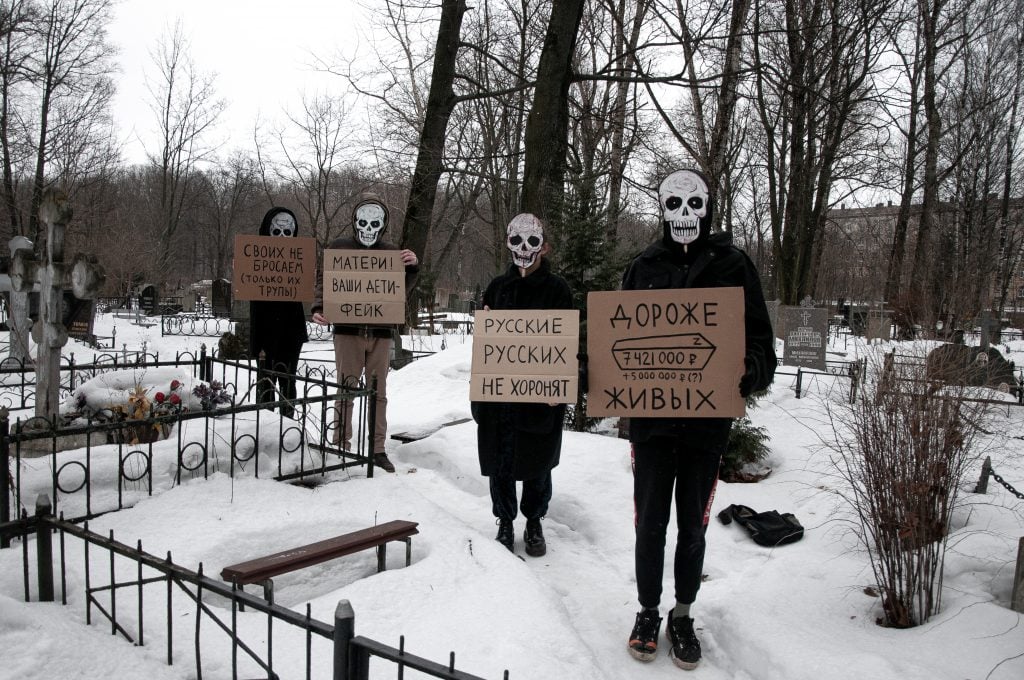
With metaphors, pseudonyms, or from exile, dissenting artists are finding ways to resist.

Paula Erizanu

“All cultural life in Russian is frozen,” Nizhny Tagil based artist Alice Hualice told Artnet News over Zoom. While the official cultural scene in Russia remains largely on pause since the invasion of Ukraine began last month, dozens of Russian artists have been producing anti-war works to share on social media. Risking prison sentences for speaking the truth about the war, Russian—as well as Belarusian—artists opposing their governments’ authoritarian rule and the war crimes taking place in Ukraine are looking for ways to keep resisting.
To do so, they hide behind metaphor, pseudonyms, or exile. Since the war began, the already oppressive government further curtailed freedom of speech in Russia, adopting new laws that make calling the invasion a “war” and not a “military operation” a criminal offence that could result in a 15-year prison sentence. As such, one of Hualice’s latest works posted to social media is a metaphorical sculpture: it is a figure of a woman with wings moulded from clay with a caption that reads Russia will be free.
“This war is the most horrific thing that’s happened to my country since I was born,” said Alice, who is 27. “I tried to create my own world, where it’s just me and my work… But as problems have kept growing over the years, politics kept interfering in private life too much, and it has been impossible for me to keep these things distinct.”
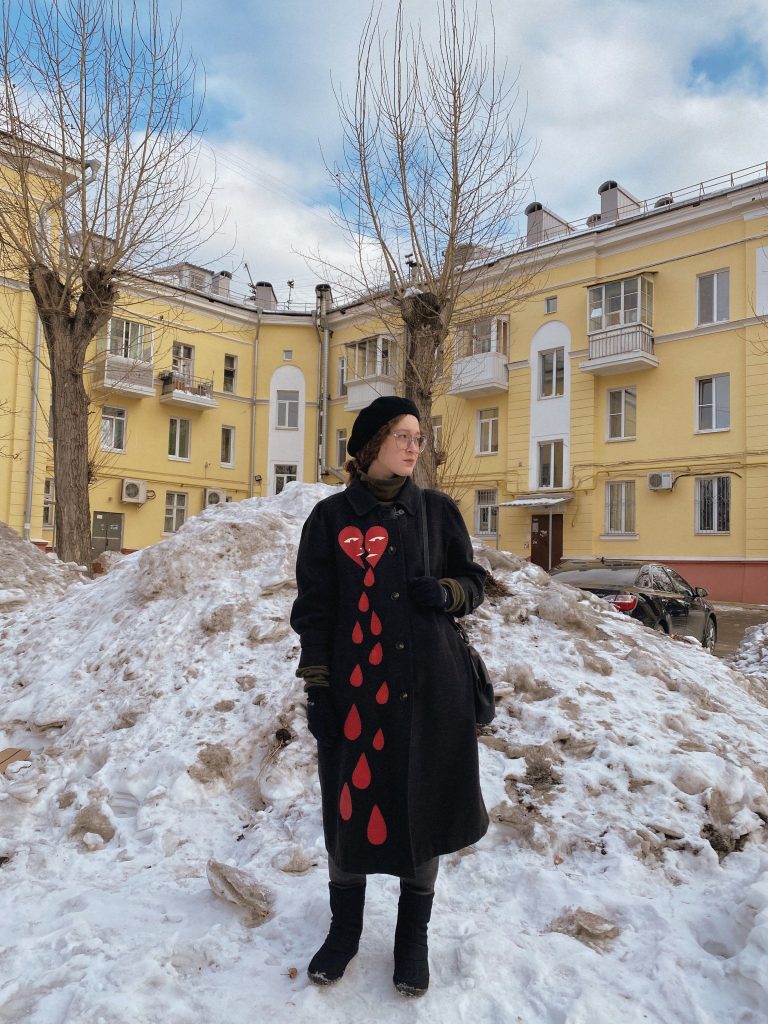
Alice Hualice wearing her anti-war coat. Courtesy the artist.
Hualice’s popular Instagram account, which usually features her otherworldly textile masks, sculptures, and clothes, pivoted on February 24, on the day of the Russian invasion, when she posted a picture of herself carrying a protest sign saying “No to war” on the snowy roads of her native Nizhny Tagil, a small town near the border between Europe and Asia, in the Sverdlovsk Oblast.
The words transpired again in her art when she sewed them onto a black coat with stitched blue tears on its back, and a split, bleeding heart on the front. She wore the piece and walked across her hometown as a performance. “I felt a lot of understanding looks, especially from women, but also some aggressive stares from a few men,” she recalled. It was a day before the Russian government adopted its new laws muzzling conversations about the war and Hualice said it would now be too dangerous for her to wear the coat again. “But if they wanted to arrest me, they could find anything against me,” she admitted. Despite the Kremlin’s recent ban of Instagram and Facebook, Russians continue to access the platforms via foreign VPNs.
Since the war began, more than 12,000 people who have been detained for protesting may have to face down Russia’s harsh new legislation laws. But the Kremlin has led a large ongoing campaign to suppress free speech in the wider cultural scene for years. Even outside the context of the Kremlin’s wars against Ukraine, Pussy Riot members and film and theatre director Kirill Serebrennikov were famously convicted for their work. Younger and less known feminist artists like Yulia Tsvetkova have also faced state repressions. A year after Tsvetkova’s conviction, feminist artist Darya Apakhonchich was labelled as “foreign agent.”
The Party of the Dead’s first reaction to Russia’s war on Ukraine came two days before the bombing began, when Russia’s National Security Council recognized the independence of two eastern Ukrainian provinces, Luhansk and Donetsk, where Russia-backed separatists have fought Ukrainian forces since 2014. In response to this news, members of the art group went to the Piskaryovskoye cemetery, where the victims of the World War 2 Leningrad siege are buried. They documented themselves carrying a sign that read “The Dead Are for Peace ” and distributed the pictures on social media.
Since the war broke out, the group has continued to organize anti-war performances, responding to Russia’s war crimes in Ukraine. “Mothers, your children are fake,” they wrote on one sign, addressing the Russian women whose sons are fighting in Ukraine, as well as the Russian laws labelling the coverage of Russia’s war crimes in Ukraine as “fake news.”
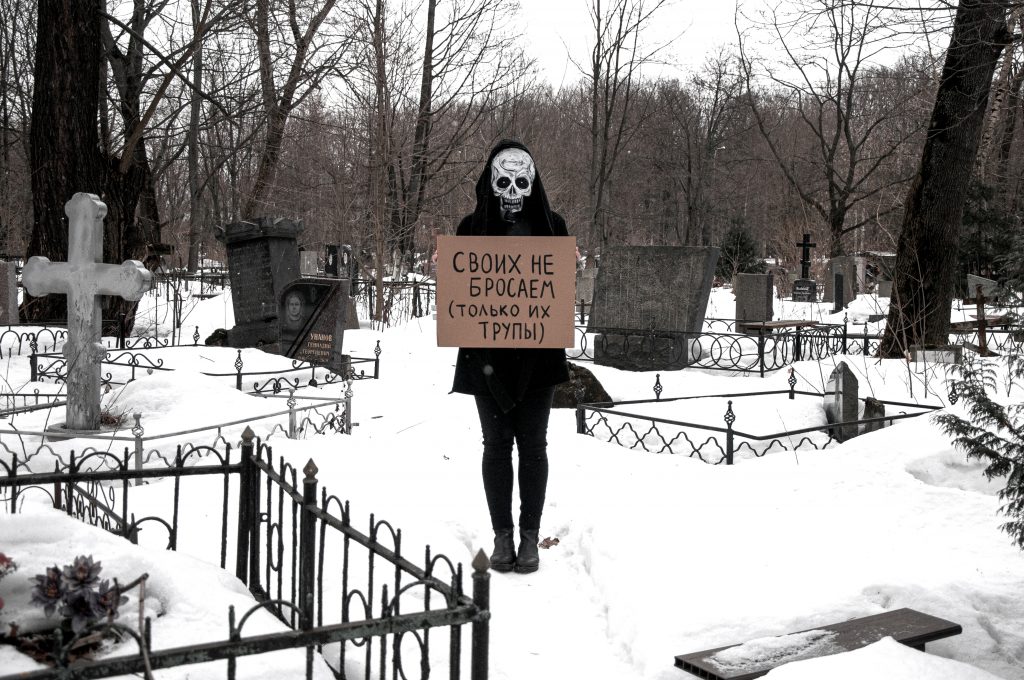
Party of the Dead on March 7. Courtesy the Party of the Dead.
In recent years, four of their members have been detained and some of the group has already defected from Russia. “We have a feeling that everything is getting worse every day,” said the founder of the group, who wanted to stay anonymous, and is for now still based in Saint Petersburg. “The protests are getting more and more difficult because of the war censorship laws. My five-year-old child is now in Georgia and I want to go there as well, while it is possible. I am afraid that the borders might get shut.”
Likewise, Yekaterinburg-based digital artist BFMTH is considering leaving Russia, although the new wave of repression doesn’t stop him from producing biting satirical images—some of which have been printed as protest signs at demonstrations in solidarity with Ukraine in London.
“Of course, I am afraid. But I can’t stop. It would be a lot worse if I stayed quiet,” he told Artnet News. The artist has been producing collages that criticize Putin’s authoritarian rule for several years. Recent collages depict Putin looking through binoculars as he hides behind overflowing bins by a Soviet tower block. “I have long been interested in this [Russian imperialism] issue, since the 2014 annexation of Crimea,” he said. “It was clear since then that everything was leading towards war.”
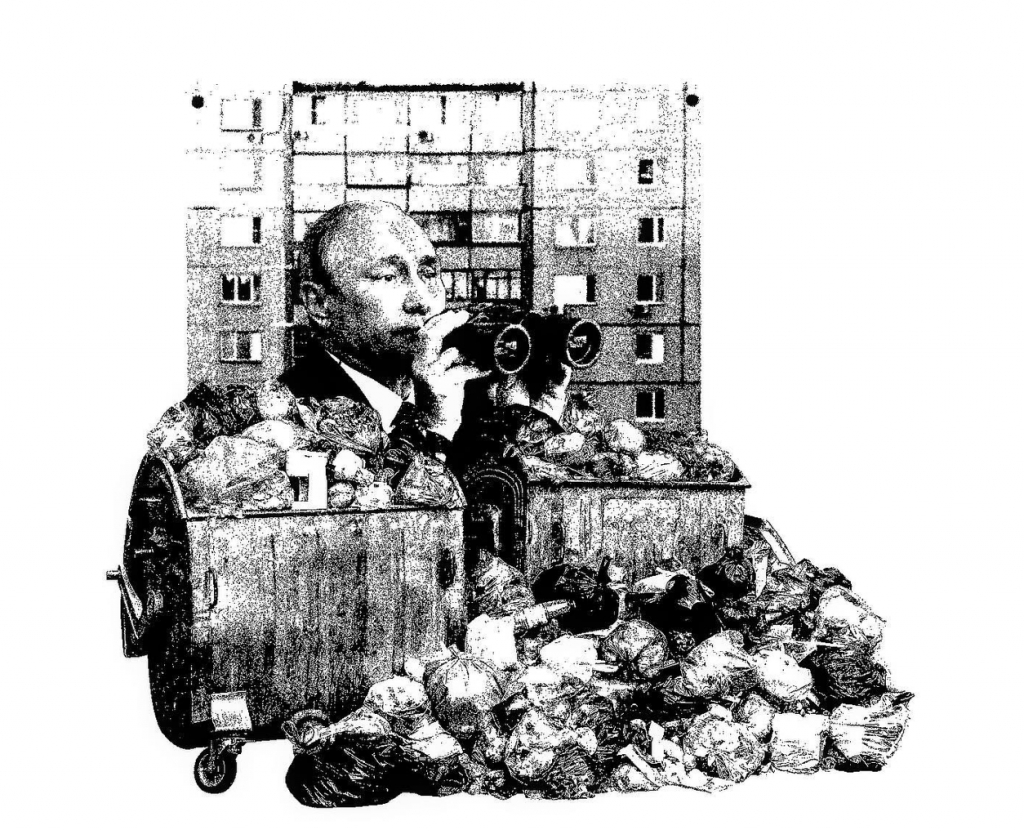
BFMTH’s Where do we clean. Courtesy the artist.
For several artists pushing back at the Russian government, the issue at hand is not just dissent, but also how to provide the needed context to arm people with information. London-based artist and academic Anna Engelhardt, who uses an alias, has also long focused on the overlooked issue of Russian colonialism, through video works that use deepfake technologies to denounce the information wars in Crimea and east Ukraine.
Despite being one of the few voices in the art world drawing attention to Russia’s colonial history, she said she “felt complicity and shame” when she heard the news of the war. “We didn’t manage to prevent this from happening,” she said. “But I tried to repurpose this shame into productive activity.” She has been active since the outbreak of war, helping relatives in Ukraine flee. She also wrote a letter to ask the Venice Biennale to ban Russia and organized a recent conference called Decolonising Russia’s War on Ukraine that featured Ukrainian voices “not just as victims but also as experts on Russian colonialism,” she told Artnet News.
Like many Russians, Engelhardt’s family has been politically divided—yet, in her case, the war in Ukraine actually brought them together. “My grandparents have always been great Putin supporters,” she said. “But my grandmother is from Ukraine, so a significant part of my family is there. When she and my grandfather talked to her relatives and realised they were in danger, I felt like both my grandparents went through an awakening, as if someone had taken the veil off their eyes; they changed their politics entirely.” But a large part of Russian society still remains loyal to Putin.
Russians’ support for the war and the government partially stems from state media propaganda. For eight years, Russian state television has been portraying Ukrainians as fascists, and Russia as a victim of the West—sanctions are only reinforcing this framework. With the state media’s propaganda in mind, London-based Belarusian artist, who asked to remain anonymous for fear of his family’s safety in Belarus, made a work called Brainwasher Ostankino, a short post-apocalyptic video animation that depicts human beings falling into the vertigo of a tv set, a reference to Moscow’s Ostankino tower, which hosts several state TV channels, radios, and newspapers.
“A lot of people don’t think much, and when you don’t think much it’s very easy for someone else to put thoughts in your head,” the artist said. “They’re not evil but a lot of people in Russia and Belarus simply don’t understand what’s going on.”
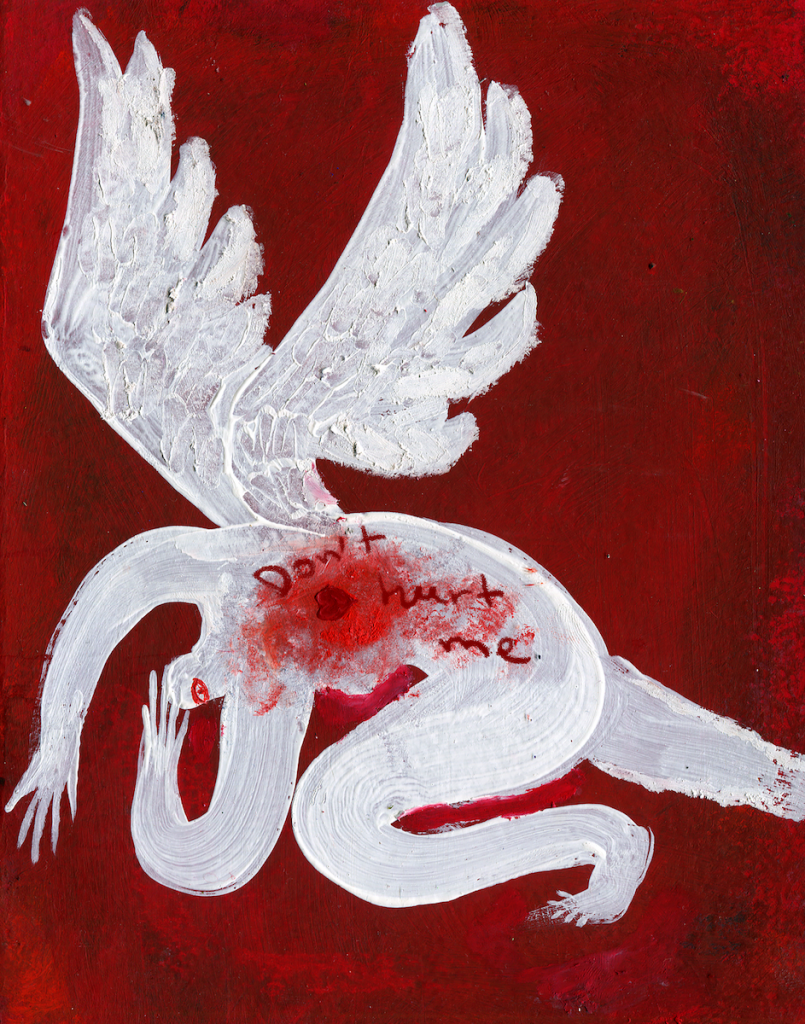
Anastasia Rydlevskaya’s poster in white and red represents the colors of the old Belarussian flag. Courtesy the artist.
The artist left Belarus six years ago together with his twin brother in order to escape the country’s mandatory military service—the Belarusian army makes young soldiers in training give up their phones and watch state television. His parents are now considering fleeing as well, due to repressions: in the last year and a half, more than 35,000 Belarusians have been detained, including 800 people in the recent anti-war protests. “It’s sad because my dad is especially patriotic, not for the government, but for the place that he has tried to help build for so long,” said the artist.
Similarly, out of fear of reprisal, the surrealist painter Anastasia Rydlevskaya, who created protest posters for her country’s pro-democracy rallies that swept the country in the wake of rigged elections in August 2020, decided to leave Belarus in November and resettle in Poland. “My country is now under the quiet occupation of Russia,” she said. Russian troops initially brought in for “military exercises” have remained in Belarus since February 20. “The only reason why we, Belarusians, didn’t win our war against Lukashenka, is because of Putin’s support for him,” she said. “When Putin and his system dies, Belarus will be free.”
If and when that time comes, Hualice’s ceramic sculpture stating “Russia will be free” will be triumphant. Until then though, in BFMTH’s words, “Russia will just continue to endure”—a notion that comes at an atrocious cost for Ukraine.